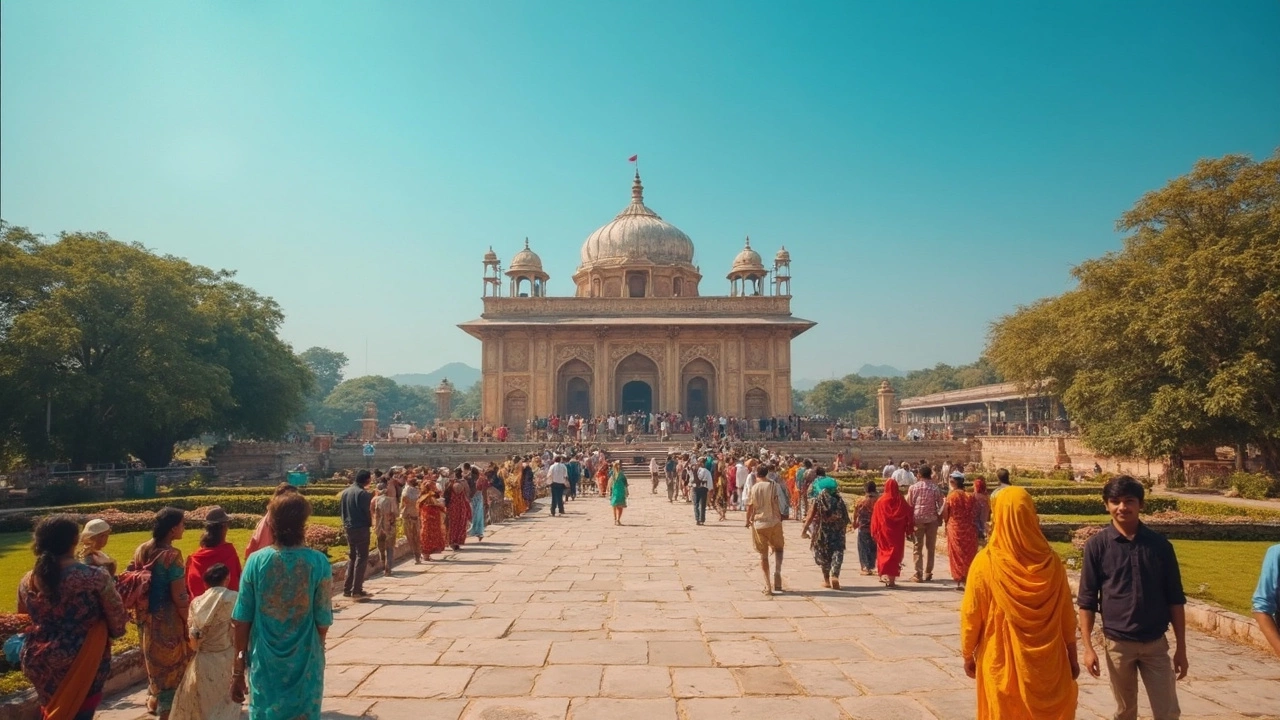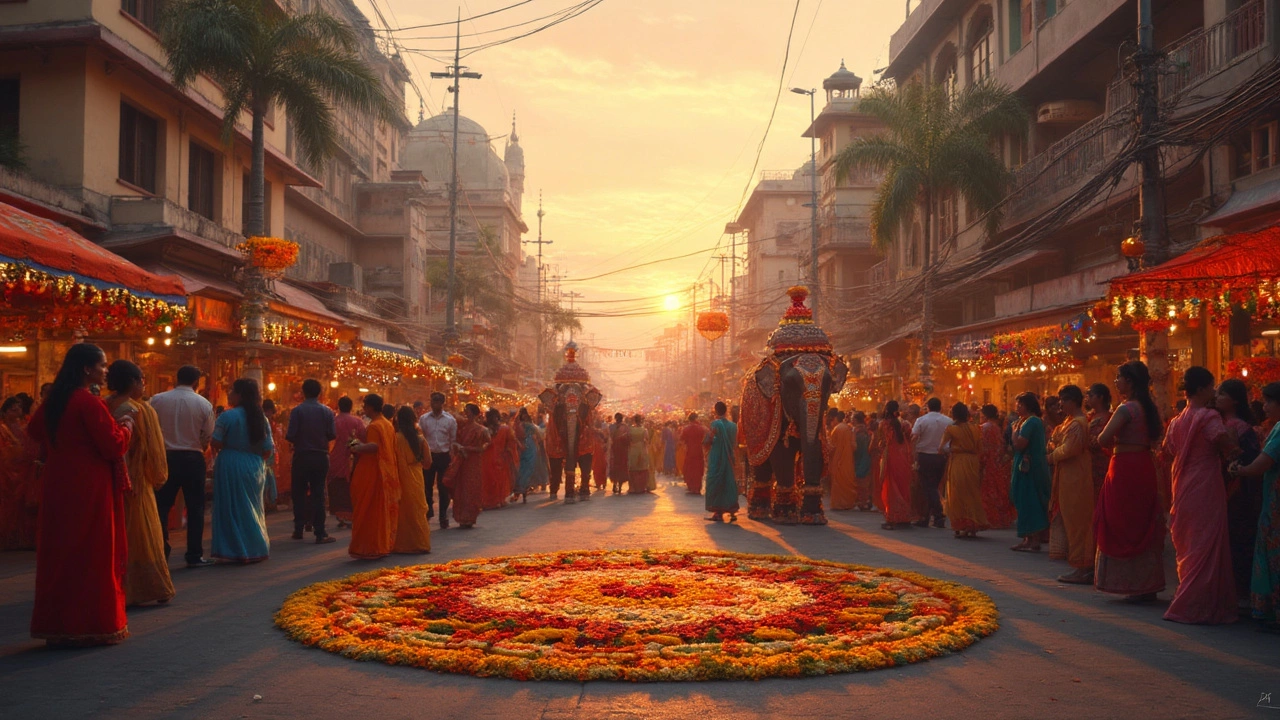If you look at the cultural map of India, Rajasthan is the state people rave about the most. But why does it keep popping up as the top destination for cultural tourism? Well, for starters, it’s oozing with palaces, forts, and stories you actually want to hear about—think camel caravans, royal dynasties, and painted havelis that still feel straight out of a movie.
What really sets Rajasthan apart is how much heritage it’s managed to keep alive. You walk into Jaipur or Udaipur and, boom, you’re hit with colorful markets, folk dancers doing their thing on the street, and food that pretty much demands you forget any diet plans. In places like Jaisalmer, you can literally sleep in a desert camp under the stars and wake up to traditional music—how many places can offer that?
But Rajasthan’s appeal isn’t just about monuments and festivals; it's also about hands-on experiences. Families here have passed down crafts like blue pottery or miniature painting for generations. You can actually chat with artisans, watch them work, and even try your hand at making something cool yourself. It’s not just a sightseeing trip; it’s like living a slice of Indian history.
- Why Rajasthan Steals the Spotlight
- Famous Festivals and Heritage Spots
- Insider Tips for Culture Lovers
- Beyond Rajasthan: Other Cultural Hotspots
Why Rajasthan Steals the Spotlight
Rajasthan has a rep for being the face of cultural tourism India—and honestly, it’s earned it. This state wears its traditions out in the open so you can’t miss them. First off, it has more major forts and palaces than anywhere else in the country. Think Jaipur’s Amber Fort, Udaipur’s City Palace, and the golden sandstone walls of Jaisalmer Fort—these places aren’t just for show. They’re active backdrops for daily life and local celebrations.
Here’s something wild: Rajasthan has literally the most UNESCO World Heritage Sites among all Indian states, with forts like Chittorgarh and Kumbhalgarh making the official list. Visiting here isn’t just about ticking off old buildings; you see history come alive. Streets are full of folks in traditional attire, even outside festivals. Every town seems to host its own folk music or dance event—all open to just drop in and enjoy.
When it comes to experiences, Rajasthan nails the basics but goes further. You can actually take camel rides through the Thar Desert, crash at heritage hotels once owned by royalty, or learn about block printing and tie-dye from families who’ve worked the same craft for centuries. Walk into any city bazaar, and you’ll find hand-made jewelry, leather goods, and tie-and-dye fabrics piled up in a way that makes shopping almost too easy.
- Number of yearly tourists (2023): Over 58 million, domestic and foreign
- Home to: India’s largest desert — the Thar
- Cuisine highlight: Dal Baati Churma and Laal Maas, both local legends
- Biggest festival: Pushkar Camel Fair, which attracts visitors worldwide
You might wonder, does it feel crowded? Rajasthan does pull in big numbers, but the cities are set up to handle it. You can wander through massive forts without bumping elbows and still stumble onto quiet back alleys or silent corners in busy city markets.
| Famous City | Main Attraction | Local Experience |
|---|---|---|
| Jaipur | Amber Fort, City Palace | Shopping for jewelry in Johari Bazaar |
| Jodhpur | Mehrangarh Fort | Trying Mirchi Bada snacks |
| Udaipur | Lake Pichola | Staying in a lakeside haveli |
| Jaisalmer | Jaisalmer Fort | Desert safari, folk music |
No other state does it quite like Rajasthan, blending heritage, hands-on crafts, and a vibe that actually makes culture fun—not just something to check off a touristy list.
Famous Festivals and Heritage Spots
If you’re into cultural tourism India is loved for, Rajasthan’s calendar is packed with festivals that offer the real deal. The Pushkar Camel Fair isn’t just a market; it’s a full-on explosion of color, music, and people from all over the world. You’ll see camel races, folk games, and a bazaar selling everything from traditional jewelry to local spices. Diwali in Jaipur is another must—thousands of lights turn the city into a sparkling maze. And if you show up for the Jaisalmer Desert Festival, you’ll catch turban-tying competitions and puppet shows you never knew you needed to see.
Heritage-wise, you’ve probably heard about Jaipur’s Amber Fort or Udaipur’s City Palace, but there’s more. Chittorgarh Fort is the largest in India and has a history tangled with epic battles and legends. Jodhpur’s Mehrangarh Fort towers so high above the old city that you can see blue houses all the way down. Even the smaller places like Bundi, with its stepwells and painted palaces, leave you amazed at how much history fits in.
According to Lonely Planet’s India travel guide, Rajasthan earns top marks because:
"No other region in India offers such a clear window into the vibrant mix of ancient traditions, royal legacy, and living culture as Rajasthan does."That’s coming from the world’s most-used travel guide.
Curious how these places stack up for visitors? Here’s a quick look at annual numbers for some top heritage sites and festivals:
| Place or Festival | Visitors per year (approx.) |
|---|---|
| Amber Fort (Jaipur) | Over 1.5 million |
| Pushkar Camel Fair | Over 400,000 |
| Mehrangarh Fort (Jodhpur) | Almost 1 million |
| Chittorgarh Fort | 600,000+ |
Here’s a tip: If you want the best photos, hit the forts early before the crowds, and if you’re at a festival, local guides can get you access to some behind-the-scenes stuff. Don’t forget most cities also have free local walking tours—great for getting the real stories, not just what’s in the guidebook.

Insider Tips for Culture Lovers
If you’re eyeing Rajasthan for cultural tourism India adventures, a few tried-and-true tips can help you make the most of it. Skip the basic tour packages—local experiences are where the real magic happens.
- Stay in a heritage haveli or palace hotel: It’s a shortcut to feeling like royalty. Many of these places are still run by former royal families, and you'll get local history straight from the source. Try Samode Haveli in Jaipur or Raas Devigarh in Udaipur.
- Plan around festivals: The Pushkar Camel Fair in November and Jaipur Literature Festival in January are wild—crowds, energy, and a chance to learn about local life in a way museums can’t offer. Book your stays months ahead, though; places fill up fast.
- Eat with locals: Small dhabas (roadside eateries) are where you’ll taste real Rajasthani thalis—dal baati churma, ker sangri, and gatte ki sabzi. Don’t shy away from food tours led by locals; you’ll learn how dishes are made and why spice mixes matter.
- Pick up a few words of Hindi or Rajasthani: Even “namaste” and “dhanyavaad” (thank you) go a long way. Locals notice, and often open up with tips or invitations most tourists never get.
- Visit small towns, not just big hits: Places like Bundi, Shekhawati, and Chittorgarh are loaded with art, old stepwells, and unique stories but see less tourist traffic. Tuk-tuk rides and walking tours in these spots can turn random afternoons into your favorite memories.
Also, bargain smart in markets. Start by offering half the stated price—don’t feel shy, it’s normal. And pack light cotton clothes, good walking shoes, and a scarf for temple visits. Finally, never skip on bottled water and always check reviews before booking local guides or experiences to avoid tourist traps.
Beyond Rajasthan: Other Cultural Hotspots
Okay, so Rajasthan sets the bar high for cultural tourism India dreams, but there’s way more out there. India has this wild mix—everybody knows it’s not a one-state show. Here’s where you should look if you want more unique stories, food, and vibes.
Kerala: Sometimes called “God’s Own Country,” Kerala’s culture is a mashup of ancient art, dance, and festivals. The Kathakali shows in Kochi are a jaw-dropper, and Onam brings a feast you won’t forget. Plus, the old spice markets in Fort Kochi have been running since the 14th century.
Tamil Nadu: Temples are everywhere in Tamil Nadu—think Madurai’s Meenakshi Temple or Brihadeeswarar in Thanjavur. The classical music and Bharatanatyam dance shows are as local as it gets. They’ve got the Pongal harvest festival, too, which usually means you’re eating really well, real fast.
West Bengal: Kolkata’s Durga Puja festival is another level, and UNESCO even listed it as an “Intangible Cultural Heritage.” If you ever walk through the city in October, every street turns into an arts and crafts parade. Add to that Tagore’s Shantiniketan for some legit literature and art culture.
Uttar Pradesh: Agra and Varanasi need no intro. But there’s more—Lucknow’s “tehzeeb” is a thing people still care about, from old-school poetry readings to classic kebabs. Varanasi’s Ganga Aarti, done every night, brings crowds that aren’t just tourists but locals too, making it electric.
Here’s a quick look at some must-see events and places across these states:
| State | Cultural Gem | Main Attraction |
|---|---|---|
| Kerala | Kathakali Dance | Kerala Kalamandalam (Thrissur) |
| Tamil Nadu | Bharatanatyam | Chidambaram Natyanjali Festival |
| West Bengal | Durga Puja | Kolkata (October each year) |
| Uttar Pradesh | Ganga Aarti | Varanasi Ghats |
Travel tip: South Indian temples have dress codes. Carry something to cover your shoulders and knees just in case. In Kolkata during Durga Puja, book hotels at least a month ahead—the city gets packed. Also, for local experiences, skip the big tours sometimes. Find a neighborhood market or a hole-in-the-wall eatery; talk to local shopkeepers, and you’ll usually find the best cultural stories that way.
